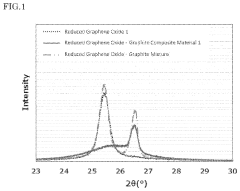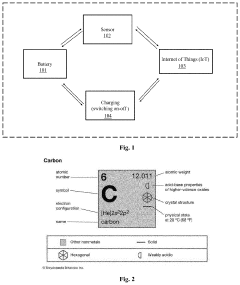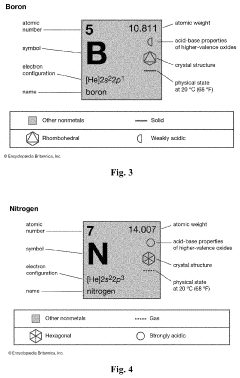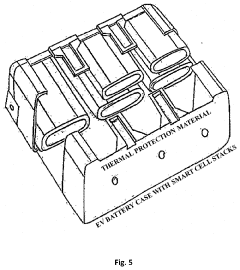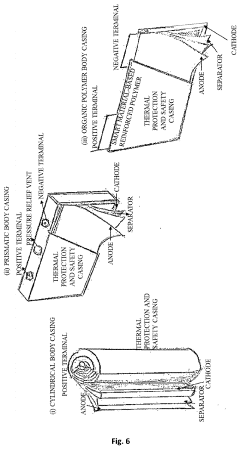How to Enhance Power Output of Graphene Batteries?
AUG 6, 20259 MIN READ
Generate Your Research Report Instantly with AI Agent
Patsnap Eureka helps you evaluate technical feasibility & market potential.
Graphene Battery Evolution and Objectives
Graphene batteries have emerged as a promising technology in the field of energy storage, offering potential advantages over traditional lithium-ion batteries. The evolution of graphene batteries can be traced back to the discovery of graphene in 2004, which sparked intense research into its applications across various industries, including energy storage.
The development of graphene batteries has been driven by the need for higher energy density, faster charging times, and improved safety in energy storage systems. Initially, researchers focused on incorporating graphene into existing battery technologies, such as lithium-ion batteries, to enhance their performance. This approach led to incremental improvements in battery capacity and charging speeds.
As research progressed, scientists began exploring the possibility of creating batteries entirely based on graphene. These efforts aimed to leverage graphene's unique properties, such as its high electrical conductivity, mechanical strength, and large surface area, to create a new generation of energy storage devices.
The evolution of graphene batteries has been marked by several key milestones. Early experiments demonstrated the potential of graphene-enhanced electrodes to improve the performance of lithium-ion batteries. Subsequently, researchers developed graphene-based supercapacitors, which offered rapid charging and discharging capabilities but limited energy density.
Recent advancements have focused on developing hybrid systems that combine the high energy density of batteries with the rapid charging capabilities of supercapacitors. These hybrid graphene batteries aim to provide a balance between power output and energy storage capacity.
The primary objective in enhancing the power output of graphene batteries is to maximize the utilization of graphene's unique properties. This involves optimizing the structure and composition of graphene-based electrodes to increase the surface area available for energy storage and improve charge transfer kinetics.
Another crucial objective is to develop scalable manufacturing processes for graphene batteries. While laboratory-scale demonstrations have shown promising results, translating these achievements into commercially viable products remains a significant challenge. Researchers are working on developing cost-effective methods for large-scale production of high-quality graphene and integrating it into battery structures.
Furthermore, enhancing the stability and longevity of graphene batteries is a key objective. This involves addressing issues such as electrode degradation, electrolyte compatibility, and overall battery lifespan to ensure that graphene batteries can outperform existing technologies in real-world applications.
As research continues, the ultimate goal is to create graphene batteries that significantly surpass the performance of current energy storage technologies, potentially revolutionizing various sectors, including electric vehicles, portable electronics, and grid-scale energy storage.
The development of graphene batteries has been driven by the need for higher energy density, faster charging times, and improved safety in energy storage systems. Initially, researchers focused on incorporating graphene into existing battery technologies, such as lithium-ion batteries, to enhance their performance. This approach led to incremental improvements in battery capacity and charging speeds.
As research progressed, scientists began exploring the possibility of creating batteries entirely based on graphene. These efforts aimed to leverage graphene's unique properties, such as its high electrical conductivity, mechanical strength, and large surface area, to create a new generation of energy storage devices.
The evolution of graphene batteries has been marked by several key milestones. Early experiments demonstrated the potential of graphene-enhanced electrodes to improve the performance of lithium-ion batteries. Subsequently, researchers developed graphene-based supercapacitors, which offered rapid charging and discharging capabilities but limited energy density.
Recent advancements have focused on developing hybrid systems that combine the high energy density of batteries with the rapid charging capabilities of supercapacitors. These hybrid graphene batteries aim to provide a balance between power output and energy storage capacity.
The primary objective in enhancing the power output of graphene batteries is to maximize the utilization of graphene's unique properties. This involves optimizing the structure and composition of graphene-based electrodes to increase the surface area available for energy storage and improve charge transfer kinetics.
Another crucial objective is to develop scalable manufacturing processes for graphene batteries. While laboratory-scale demonstrations have shown promising results, translating these achievements into commercially viable products remains a significant challenge. Researchers are working on developing cost-effective methods for large-scale production of high-quality graphene and integrating it into battery structures.
Furthermore, enhancing the stability and longevity of graphene batteries is a key objective. This involves addressing issues such as electrode degradation, electrolyte compatibility, and overall battery lifespan to ensure that graphene batteries can outperform existing technologies in real-world applications.
As research continues, the ultimate goal is to create graphene batteries that significantly surpass the performance of current energy storage technologies, potentially revolutionizing various sectors, including electric vehicles, portable electronics, and grid-scale energy storage.
Market Demand Analysis for High-Power Batteries
The market demand for high-power batteries has been experiencing significant growth, driven by the increasing need for energy storage solutions in various sectors. The automotive industry, particularly the electric vehicle (EV) segment, stands at the forefront of this demand. As governments worldwide implement stricter emissions regulations and consumers become more environmentally conscious, the shift towards EVs has accelerated, creating a substantial market for high-performance batteries.
In the EV sector, the demand for batteries with higher power output is crucial for improving vehicle performance, extending driving range, and reducing charging times. This has led to a surge in research and development efforts focused on enhancing battery technologies, with graphene batteries emerging as a promising solution. The potential of graphene to significantly boost power output aligns well with the market's requirements for more efficient energy storage systems.
Beyond the automotive sector, the renewable energy industry is another key driver of demand for high-power batteries. As the world transitions towards cleaner energy sources, the need for efficient energy storage solutions to manage intermittent power generation from solar and wind sources has become paramount. High-power batteries play a crucial role in grid stabilization and energy management, further fueling market growth.
The consumer electronics industry also contributes to the demand for high-power batteries. With the proliferation of smartphones, laptops, and other portable devices, consumers are increasingly seeking longer battery life and faster charging capabilities. Graphene batteries, with their potential for higher power output and quicker charging times, could revolutionize the consumer electronics landscape.
In the industrial sector, the adoption of automation and robotics has created a need for more powerful and reliable energy storage solutions. High-power batteries are essential for powering industrial equipment, autonomous vehicles, and other applications that require sustained high-performance energy delivery.
Market analysts project substantial growth in the high-power battery market over the coming years. The global lithium-ion battery market, which includes high-power applications, is expected to grow at a compound annual growth rate (CAGR) of over 12% from 2021 to 2028. Within this broader market, the demand for advanced battery technologies like graphene-enhanced batteries is anticipated to grow even more rapidly as industries seek to leverage their superior performance characteristics.
As research into graphene batteries progresses, the potential for enhanced power output could address many of the current limitations in battery technology. This aligns perfectly with the market's demand for more efficient, longer-lasting, and faster-charging energy storage solutions across multiple industries.
In the EV sector, the demand for batteries with higher power output is crucial for improving vehicle performance, extending driving range, and reducing charging times. This has led to a surge in research and development efforts focused on enhancing battery technologies, with graphene batteries emerging as a promising solution. The potential of graphene to significantly boost power output aligns well with the market's requirements for more efficient energy storage systems.
Beyond the automotive sector, the renewable energy industry is another key driver of demand for high-power batteries. As the world transitions towards cleaner energy sources, the need for efficient energy storage solutions to manage intermittent power generation from solar and wind sources has become paramount. High-power batteries play a crucial role in grid stabilization and energy management, further fueling market growth.
The consumer electronics industry also contributes to the demand for high-power batteries. With the proliferation of smartphones, laptops, and other portable devices, consumers are increasingly seeking longer battery life and faster charging capabilities. Graphene batteries, with their potential for higher power output and quicker charging times, could revolutionize the consumer electronics landscape.
In the industrial sector, the adoption of automation and robotics has created a need for more powerful and reliable energy storage solutions. High-power batteries are essential for powering industrial equipment, autonomous vehicles, and other applications that require sustained high-performance energy delivery.
Market analysts project substantial growth in the high-power battery market over the coming years. The global lithium-ion battery market, which includes high-power applications, is expected to grow at a compound annual growth rate (CAGR) of over 12% from 2021 to 2028. Within this broader market, the demand for advanced battery technologies like graphene-enhanced batteries is anticipated to grow even more rapidly as industries seek to leverage their superior performance characteristics.
As research into graphene batteries progresses, the potential for enhanced power output could address many of the current limitations in battery technology. This aligns perfectly with the market's demand for more efficient, longer-lasting, and faster-charging energy storage solutions across multiple industries.
Current Challenges in Graphene Battery Technology
Despite the promising potential of graphene batteries, several significant challenges currently hinder their widespread adoption and performance optimization. One of the primary obstacles is the scalability of graphene production. While laboratory-scale synthesis of high-quality graphene has been achieved, translating this to industrial-scale production while maintaining consistent quality and properties remains a formidable task.
The integration of graphene into existing battery architectures poses another substantial challenge. Graphene's unique properties, such as its high surface area and excellent conductivity, can lead to unintended side reactions and electrolyte decomposition, potentially compromising the battery's long-term stability and cycle life. Researchers are grappling with finding the optimal balance between graphene content and other battery components to maximize performance without sacrificing durability.
Another critical issue is the development of effective methods to prevent graphene sheets from restacking during battery operation. The tendency of graphene layers to aggregate due to van der Waals forces can significantly reduce the active surface area, diminishing the battery's capacity and power output. Innovative approaches to maintain graphene's dispersed state throughout the battery's lifecycle are crucial for realizing its full potential.
The challenge of achieving high-loading electrodes with graphene-based materials is also a significant hurdle. While graphene can enhance the conductivity and stability of battery electrodes, incorporating high amounts of active materials without compromising structural integrity and electron/ion transport pathways remains difficult. This limitation directly impacts the energy density and power output of graphene batteries.
Furthermore, the cost-effectiveness of graphene battery technology presents a substantial barrier to commercialization. The current production methods for high-quality graphene are expensive, making it challenging to compete with established battery technologies on a cost basis. Developing more economical synthesis techniques and optimizing the amount of graphene required for significant performance improvements are essential for market viability.
Lastly, the environmental impact and safety concerns associated with graphene production and disposal need to be thoroughly addressed. As a relatively new material, the long-term environmental effects of graphene are not yet fully understood. Ensuring sustainable production methods and developing recycling strategies for graphene-based batteries are crucial challenges that need to be overcome to make this technology truly viable for large-scale adoption.
The integration of graphene into existing battery architectures poses another substantial challenge. Graphene's unique properties, such as its high surface area and excellent conductivity, can lead to unintended side reactions and electrolyte decomposition, potentially compromising the battery's long-term stability and cycle life. Researchers are grappling with finding the optimal balance between graphene content and other battery components to maximize performance without sacrificing durability.
Another critical issue is the development of effective methods to prevent graphene sheets from restacking during battery operation. The tendency of graphene layers to aggregate due to van der Waals forces can significantly reduce the active surface area, diminishing the battery's capacity and power output. Innovative approaches to maintain graphene's dispersed state throughout the battery's lifecycle are crucial for realizing its full potential.
The challenge of achieving high-loading electrodes with graphene-based materials is also a significant hurdle. While graphene can enhance the conductivity and stability of battery electrodes, incorporating high amounts of active materials without compromising structural integrity and electron/ion transport pathways remains difficult. This limitation directly impacts the energy density and power output of graphene batteries.
Furthermore, the cost-effectiveness of graphene battery technology presents a substantial barrier to commercialization. The current production methods for high-quality graphene are expensive, making it challenging to compete with established battery technologies on a cost basis. Developing more economical synthesis techniques and optimizing the amount of graphene required for significant performance improvements are essential for market viability.
Lastly, the environmental impact and safety concerns associated with graphene production and disposal need to be thoroughly addressed. As a relatively new material, the long-term environmental effects of graphene are not yet fully understood. Ensuring sustainable production methods and developing recycling strategies for graphene-based batteries are crucial challenges that need to be overcome to make this technology truly viable for large-scale adoption.
Existing Power Enhancement Techniques
01 Graphene-enhanced electrode materials
Graphene is incorporated into battery electrodes to improve conductivity and increase power output. This enhancement allows for faster charge and discharge rates, leading to higher power density in graphene-based batteries. The use of graphene in electrode materials can significantly boost the overall performance and efficiency of the battery.- Graphene-based electrode materials for high power output: Graphene-based materials are used as electrodes in batteries to enhance power output. The unique properties of graphene, such as high conductivity and large surface area, contribute to improved energy storage and faster charge/discharge rates. These electrodes can be fabricated using various methods to optimize their performance in battery applications.
- Graphene-enhanced battery management systems: Integration of graphene in battery management systems improves overall power output and efficiency. Graphene-based sensors and control circuits enable more accurate monitoring of battery parameters, leading to optimized charging and discharging processes. This results in enhanced power delivery and extended battery life.
- Graphene-based thermal management for batteries: Graphene's excellent thermal conductivity is utilized to enhance heat dissipation in batteries, allowing for higher power output without compromising safety. Graphene-based heat spreaders and thermal interface materials are incorporated into battery designs to maintain optimal operating temperatures and prevent thermal runaway.
- Graphene-enhanced electrolytes for improved power performance: Graphene-based additives or modifications to battery electrolytes lead to enhanced ionic conductivity and improved power output. These advanced electrolytes facilitate faster ion transport between electrodes, resulting in higher current densities and improved overall battery performance.
- Hybrid graphene-based energy storage systems: Combining graphene batteries with other energy storage technologies creates hybrid systems with improved power output characteristics. These systems leverage the strengths of different storage mechanisms to provide high power density, fast charging capabilities, and enhanced overall performance for various applications.
02 Graphene-based composite materials for energy storage
Composite materials combining graphene with other substances are developed to enhance energy storage capacity and power output. These composites can include graphene mixed with metal oxides, polymers, or other nanomaterials to create high-performance battery components. The synergistic effects of these combinations result in improved energy density and power delivery.Expand Specific Solutions03 Graphene-enabled supercapacitors for high power applications
Graphene is utilized in supercapacitor designs to achieve rapid charge and discharge capabilities, resulting in high power output. These graphene-based supercapacitors can complement or replace traditional batteries in applications requiring burst power delivery. The unique properties of graphene allow for the development of energy storage devices with superior power density.Expand Specific Solutions04 Graphene-based thermal management for battery systems
Graphene's excellent thermal conductivity is leveraged to enhance heat dissipation in battery systems, allowing for higher power output without compromising safety. By incorporating graphene into battery components or as part of the thermal management system, the overall efficiency and performance of the battery can be improved, especially under high-power conditions.Expand Specific Solutions05 Graphene-enhanced current collectors and interconnects
Graphene is used to improve the performance of current collectors and interconnects within battery systems, reducing internal resistance and enhancing power output. By utilizing graphene's high conductivity and mechanical strength, the efficiency of charge transfer within the battery is increased, leading to improved overall power performance and reduced energy losses.Expand Specific Solutions
Key Players in Graphene Battery Industry
The graphene battery market is in its early growth stage, characterized by rapid technological advancements and increasing investments. The global market size for graphene batteries is projected to expand significantly in the coming years, driven by the demand for high-performance energy storage solutions. While the technology is still evolving, several key players are making strides in enhancing power output. Companies like Contemporary Amperex Technology Co., Ltd. and Honeycomb Battery Co. are at the forefront of graphene battery development, focusing on improving energy density and charging speeds. Academic institutions such as Zhejiang University and Northwestern University are contributing to fundamental research, while established electronics giants like Samsung Electronics Co., Ltd. and Apple, Inc. are exploring graphene battery applications for consumer devices.
Contemporary Amperex Technology Co., Ltd.
Technical Solution: Contemporary Amperex Technology Co., Ltd. (CATL), a leading battery manufacturer, has been exploring graphene-enhanced battery technologies to improve power output and overall performance. CATL's approach involves incorporating graphene into lithium-ion battery electrodes to enhance conductivity and charge transfer efficiency. The company has developed a graphene-based fast-charging battery technology that can achieve an 80% charge in just 15 minutes [6]. CATL's research also focuses on using graphene to improve the stability and longevity of high-nickel cathode materials, which are crucial for increasing energy density. Additionally, the company is investigating the potential of graphene in solid-state battery designs, aiming to combine the benefits of graphene with the safety and energy density advantages of solid-state technology [7].
Strengths: Established battery manufacturing infrastructure, potential for rapid commercialization of graphene-enhanced batteries. Weaknesses: Competition from other emerging battery technologies, challenges in maintaining cost-effectiveness while incorporating graphene.
Apple, Inc.
Technical Solution: Apple has been investing in graphene battery technology to enhance the power output and efficiency of their devices. The company's approach focuses on developing graphene-based components for lithium-ion batteries, particularly targeting improvements in energy density and charging speeds. Apple's research includes the use of graphene as a heat spreader in battery systems, which helps to manage thermal issues and potentially increase the overall lifespan of the battery. Additionally, the company has explored the integration of graphene-based electrodes in their battery designs to improve conductivity and charge transfer rates. While specific details of Apple's graphene battery technology are not publicly disclosed, patent filings suggest they are working on methods to produce high-quality graphene at scale for battery applications [5].
Strengths: Strong research and development capabilities, potential for seamless integration into existing product lines. Weaknesses: Limited public information on specific technological advancements, potential challenges in scaling production for consumer electronics.
Core Innovations in Graphene Electrode Design
Reduced graphene oxide-graphite composite material, method for producing same, and lithium ion secondary battery using same
PatentActiveUS20210399300A1
Innovation
- A reduced graphene oxide-graphite composite material is formed through thermal treatment of graphene oxide and graphite, resulting in a higher C—O/C═O functional group ratio, which improves the charge and discharge efficiency by suppressing side reactions and reducing irreversible capacity.
Systems, methods and apparatus for improving rechargeable energy storage devices and integrated circuits
PatentActiveUS20230092765A1
Innovation
- The development of a smart rechargeable energy storage device using pure organic carbon-based graphene in a solid-state configuration, with graphene sheets forming the anode and cathode electrodes and serving as a separator, enabling faster charging, longer cycle life, and enhanced energy density, while eliminating safety hazards through self-healing and safer materials.
Environmental Impact of Graphene Battery Production
The production of graphene batteries, while promising for enhancing power output, carries significant environmental implications that warrant careful consideration. The manufacturing process of graphene involves energy-intensive methods such as chemical vapor deposition or exfoliation of graphite, which can contribute to increased carbon emissions if not managed properly. Additionally, the use of chemicals in graphene synthesis may lead to potential environmental contamination if proper waste management protocols are not implemented.
However, the environmental impact of graphene battery production should be weighed against its potential benefits. Graphene batteries offer higher energy density and faster charging capabilities compared to traditional lithium-ion batteries, potentially reducing the overall number of batteries needed and extending their lifespan. This could lead to a decrease in electronic waste and the demand for raw materials in the long term.
The extraction and processing of raw materials for graphene production, such as graphite, also raise environmental concerns. Mining operations can lead to habitat destruction, soil erosion, and water pollution if not conducted responsibly. It is crucial for manufacturers to source materials from suppliers adhering to strict environmental standards and sustainable practices.
Water usage is another critical factor in graphene battery production. The purification and processing of graphene often require significant amounts of water, which could strain local water resources in areas of production. Implementing water recycling systems and optimizing production processes can help mitigate this impact.
On the positive side, graphene's unique properties may enable the development of more environmentally friendly battery technologies. For instance, graphene-based supercapacitors could potentially replace certain types of batteries, offering rapid charging and discharging with minimal environmental impact during production and disposal.
The end-of-life management of graphene batteries is an area that requires further research and development. While graphene itself is not toxic, the composite materials used in battery construction may pose recycling challenges. Developing efficient recycling processes for graphene batteries will be crucial in minimizing their environmental footprint and promoting a circular economy approach.
As the technology advances, it is imperative for researchers and manufacturers to continually assess and improve the environmental performance of graphene battery production. This includes exploring greener synthesis methods, optimizing resource use, and designing batteries with recyclability in mind. By addressing these environmental concerns proactively, the graphene battery industry can work towards enhancing power output while minimizing its ecological impact.
However, the environmental impact of graphene battery production should be weighed against its potential benefits. Graphene batteries offer higher energy density and faster charging capabilities compared to traditional lithium-ion batteries, potentially reducing the overall number of batteries needed and extending their lifespan. This could lead to a decrease in electronic waste and the demand for raw materials in the long term.
The extraction and processing of raw materials for graphene production, such as graphite, also raise environmental concerns. Mining operations can lead to habitat destruction, soil erosion, and water pollution if not conducted responsibly. It is crucial for manufacturers to source materials from suppliers adhering to strict environmental standards and sustainable practices.
Water usage is another critical factor in graphene battery production. The purification and processing of graphene often require significant amounts of water, which could strain local water resources in areas of production. Implementing water recycling systems and optimizing production processes can help mitigate this impact.
On the positive side, graphene's unique properties may enable the development of more environmentally friendly battery technologies. For instance, graphene-based supercapacitors could potentially replace certain types of batteries, offering rapid charging and discharging with minimal environmental impact during production and disposal.
The end-of-life management of graphene batteries is an area that requires further research and development. While graphene itself is not toxic, the composite materials used in battery construction may pose recycling challenges. Developing efficient recycling processes for graphene batteries will be crucial in minimizing their environmental footprint and promoting a circular economy approach.
As the technology advances, it is imperative for researchers and manufacturers to continually assess and improve the environmental performance of graphene battery production. This includes exploring greener synthesis methods, optimizing resource use, and designing batteries with recyclability in mind. By addressing these environmental concerns proactively, the graphene battery industry can work towards enhancing power output while minimizing its ecological impact.
Scalability and Commercialization Prospects
The scalability and commercialization prospects for graphene batteries with enhanced power output are promising, yet they face several challenges. The potential for large-scale production is a key factor in determining the viability of graphene batteries in the commercial market. Current manufacturing processes for high-quality graphene are often complex and costly, limiting mass production capabilities. However, recent advancements in chemical vapor deposition (CVD) and liquid-phase exfoliation techniques show potential for scaling up graphene production.
To achieve commercial success, it is crucial to develop cost-effective and efficient manufacturing methods that can produce graphene batteries at scale without compromising their enhanced power output. This includes optimizing the synthesis of graphene materials, improving electrode fabrication processes, and streamlining battery assembly techniques. Collaborations between research institutions and industry partners are essential to bridge the gap between laboratory-scale demonstrations and industrial-scale production.
The market demand for high-performance energy storage solutions across various sectors, including electric vehicles, consumer electronics, and renewable energy systems, presents significant opportunities for graphene batteries. As the technology matures and production costs decrease, graphene batteries could potentially disrupt the current lithium-ion battery market. However, to achieve widespread adoption, manufacturers must address concerns related to long-term stability, safety, and environmental impact.
Regulatory compliance and standardization are critical factors in the commercialization process. Establishing industry standards for graphene battery production, performance metrics, and safety protocols will be necessary to ensure consistent quality and build consumer trust. Additionally, securing intellectual property rights and navigating the patent landscape will be crucial for companies looking to commercialize graphene battery technology.
Investment in research and development, as well as in manufacturing infrastructure, will be required to overcome the current limitations and scale up production. Government support, in the form of funding and policy incentives, could play a significant role in accelerating the commercialization of graphene batteries. As the technology progresses, strategic partnerships between graphene producers, battery manufacturers, and end-users will be essential to create a robust supply chain and drive market adoption.
To achieve commercial success, it is crucial to develop cost-effective and efficient manufacturing methods that can produce graphene batteries at scale without compromising their enhanced power output. This includes optimizing the synthesis of graphene materials, improving electrode fabrication processes, and streamlining battery assembly techniques. Collaborations between research institutions and industry partners are essential to bridge the gap between laboratory-scale demonstrations and industrial-scale production.
The market demand for high-performance energy storage solutions across various sectors, including electric vehicles, consumer electronics, and renewable energy systems, presents significant opportunities for graphene batteries. As the technology matures and production costs decrease, graphene batteries could potentially disrupt the current lithium-ion battery market. However, to achieve widespread adoption, manufacturers must address concerns related to long-term stability, safety, and environmental impact.
Regulatory compliance and standardization are critical factors in the commercialization process. Establishing industry standards for graphene battery production, performance metrics, and safety protocols will be necessary to ensure consistent quality and build consumer trust. Additionally, securing intellectual property rights and navigating the patent landscape will be crucial for companies looking to commercialize graphene battery technology.
Investment in research and development, as well as in manufacturing infrastructure, will be required to overcome the current limitations and scale up production. Government support, in the form of funding and policy incentives, could play a significant role in accelerating the commercialization of graphene batteries. As the technology progresses, strategic partnerships between graphene producers, battery manufacturers, and end-users will be essential to create a robust supply chain and drive market adoption.
Unlock deeper insights with Patsnap Eureka Quick Research — get a full tech report to explore trends and direct your research. Try now!
Generate Your Research Report Instantly with AI Agent
Supercharge your innovation with Patsnap Eureka AI Agent Platform!
